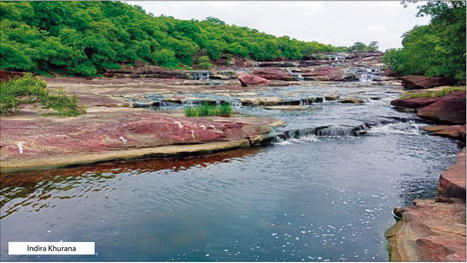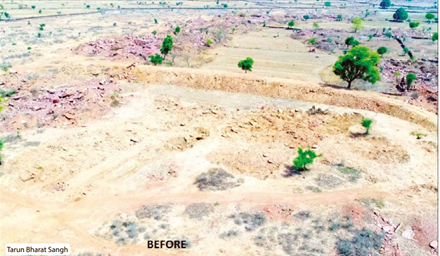
Home >> Newsletters > GreenFriends Newsletters > Q1 2024 Newsletter
| Home | Source Reduction | Friends of Green Friends | Newsletters |
| Gardening | Resources | What You Can Do | Embracing The Trees |
| Rejuvenation of Rivers |
 Life flows with a flowing Sairni River |
|
Tarun Bharat Sangh is a renowned Indian NGO working since 1975 towards climate change mitigation and adaptation by promoting water conservation, sustainable agriculture and rural development in the arid and semi-arid regions of India. Groundwater scarcity has placed a significant strain on rural areas, prompting migrations to urban centers for work and compelling farmers to sell their livestock - a crucial source of income and cultural identity. This situation disproportionately affects women and girls remaining in villages, impacting their health, education, and economic prospects. To combat this, water conservation initiatives are essential for both alleviating water scarcity's effects and aiding in climate adaptation and rural development. Forty years ago, Dr. Rajendra Singh, Chairperson of Tarun Bharat Sangh, gave up his government job to pursue more meaningful opportunities and landed in Gopalpura village, one of the hundreds of water-scarce villages in Rajasthan. Night-blindness was prevalent due to malnutrition as agriculture was nearly impossible and food was hard to come by. In desperation, youth had left to eke out a living, leaving behind the older generation. Dr. Rajendra went around treating these elder villagers for night-blindness. An old villager whom he treated berated him. The villager said, "If you genuinely want to make a difference, you must address the root cause – lack of water." Dr. Rajendra asked if the villager could help him learn since he knew nothing about the issue. He agreed to help. Steeped in indigenous wisdom on harvesting rain and replenishing water resources, the villager shared his mantra – “Capture the raindrop and gently direct it into the ground.” He guided Dr. Rajendra on where and which structures to build. Slowly the work gained momentum. As the wells started to fill, the youth returned to restart agriculture. As water conservation work expanded, the forests grew, and rivers began to flow, leading to prosperity and a life of dignity. The rainfall needs to be harvested for groundwater recharge. Water conservation structures called Bandhs slow the flow of the rain, capturing the raindrops and nudging them to recharge the groundwater. A bandh is a physical barrier, an embankment or a dam-like structure often made of earth, stone, or concrete, constructed across a slope to control the flow of water. Suitability of the location of the structure depends on an understanding of the local ecology, topography, geology, and rainfall pattern. India’s ancient water conservation wisdom is based on this knowledge. |
|
Slowly, this water captured in the bandh restores the lost connection between ground and surface water. With the strengthened connection, rivers can be brought back from their ill-health by focusing on the various streams that contribute to its flow. For rivers to be healthy, these small streams and rivulets must be rejuvenated. Slowly, the entire river is awakened and flows freely, sometimes even perennially. The bandhs must be maintained to avoid erosion and breaking and the land of a river along with its flood plains must be protected against encroachment and over extraction. The bandh structures created must be with people's involvement. This results in ownership and care of the structures so created. Communities contribute cash, kind, and labor for creation of the structure and with the benefits accrued, can manage the maintenance by themselves. A handover of the structures to communities helps build responsibility. One of the many examples of success stories after river rejuvenation was in Naharpura village, which was without water and totally barren. To make ends meet, the people were involved in mining or theft, or in rearing stolen buffaloes. Tarun Bharat Sangh worked with the community members towards making the village water sufficient, thus leading to food and livelihood security and improvement in quality of life. But first they had to urge the people to give up their illegal activities and ‘pick up the plough’ for agriculture. A bandh was constructed in the village. After the first monsoon rains, there was a marked difference in water availability. Wells filled up and fields came alive again, humming with agricultural activity. Additionally, the water available in Naharpura is used by local livestock and the livestock of nearby villages. Khurwa, a villager, said, "We had stayed away from our fields, because our land was not worth watching over since there was no water, and we were not growing crops. When we saw that water was now available, we quickly began working in our fields to make these cultivable. If it was not for water, I would not be here, and neither would you. It’s water that has brought us together." Khurwa’s son Lokendra added, "With this bandh will come stability, prosperity and peace of mind." |
 The bald landscape before work on the Sairni began |
|
Through the pioneering efforts of Tarun Bharat Sangh, it has been demonstrated that leveraging local ecology and community-driven water conservation strategies can significantly enhance climate resilience and water security. This approach has successfully regenerated natural ecosystems, revitalizing groundwater levels, rejuvenating rivers, expanding forests, enriching biodiversity, and fostering socio-economic transformation, including improved livelihoods, increased rainfall, and cooler temperatures. Initiatives in Rajasthan and Maharashtra have showcased the effectiveness of indigenous knowledge and participatory methods in revitalizing water sources, even in challenging environments such as the rocky terrains of the Sairni River or drought-stricken areas like Sangli district. Read more about Tarun Bharat Sangh's water conservation efforts at https://tarunbharatsangh.in/environment/#WaterConservation Extracted from “Rejuvenation of Rivers” by Dr. Rajendra Singh and Dr. Indira Khurana with contributions by GFNA team |
 Changed landscape after water conservation efforts |
Read The Sentience of Plants in the Q4 2024 Newsletter >>
| Home | Source Reduction | Friends of Green Friends | Newsletters | Resources | What You Can Do | Embracing The Trees |
For more information, e-mail info@greenfriendsna.org |
||||||
